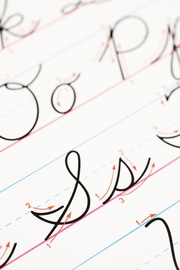How to Introduce Cursive Writing to Kids
Learning how to write cursive is a fantastic skill you can teach your children! In the age of computers, handwriting seems like a thing of the past. However, there are still many benefits as to why your kid should learn to write in cursive. In this blog, we’ll help you teach your kids cursive and know more about its perks.
Why should you teach your kids how to write cursive?
Cursive writing is more than a life skill of being able to form beautiful letters across the paper. It allows your child to express his uniqueness and creativity through writing. This type of writing can help your kid in the long run. Here are some benefits of cursive writing that your kids can enjoy:
Cursive helps improve your kid’s motor skills
Writing in cursive uses a lot of hand-eye coordination. Like sports, the writing movements cause your kid’s brain to create new connections, allowing them to hone their motor skills and overall developmental growth.
Cursive writing is good for your child’s brain
This form of writing engages the brain of your child more than we know. Research shows that cursive activates regions of the brain responsible for thinking, language, and memory.
This form of brain exercise improves cognitive health and development. Studies also show that kids who know cursive perform better on reading and spelling tests. You can also try activities such as literacy crafts to complement all the brain activity your kid is experiencing due to cursive writing.
Cursive forms discipline and helps with your kid’s self-esteem
Learning how to write in cursive takes time and effort. With constant practice, your kid takes the lead in improving their writing skills and instills self-discipline. As your child gets closer to mastering cursive, giving them praise for their progress boosts their self-esteem.
How to teach your child cursive writing?
Teaching your child how to write cursive may seem like a daunting task. With these steps, we’ll help you teach your kid to learn cursive.
Start from scratch
Remember that cursive writing may seem completely different and new to your kid. Your child has to learn to read and write the whole alphabet once again using his alphabet recognition skills. It is essential to guide them every step of the way.
Teach proper form of writing
Depending on what type of cursive you are teaching, it is important to have an appropriate posture for writing. Make sure that your kid’s hand, paper, and pen are all placed appropriately.
The standard angle to slant paper when writing cursive is somewhere between 30-40 degrees. Right-handed children slant their paper to the left, while left-handed kids have theirs tilted to the right.
Neatness is not the priority
Don’t focus too much on making sure that your kid’s handwriting is prim and proper. Let your child get the hang of the hand movements needed in cursive writing. It is more important for your child to develop proper muscle memory in writing cursive. Their neatness can always be improved later on.
Practice leads to better cursive writing
Learning cursive can be very hard work! Don’t expect your kid to master cursive all of a sudden. It takes a lot of mental and motor skills to develop handwriting. Set up regular practice sessions for writing cursive and celebrate his steady improvements instead.
Teach the letters individually and together
Start with lowercase letters before your progress into uppercase. Your child will find connecting lowercase letters easier and helps him get used to connecting letters together in a flowing way. It also helps to teach your kid cursive letters grouped by similar hand motions.
Write with your child
Show your child how to write each letter when teaching him cursive. It is easier for him to learn and remember how to form the letters if you guide him through it. Try explaining to him each step needed to form the letters. Remember to use a calm voice when doing so.
Don’t be afraid to write long words
Once your kid can write each alphabet letter, teach him how to write words together. Over time, move on to sentences and even paragraphs in cursive.




